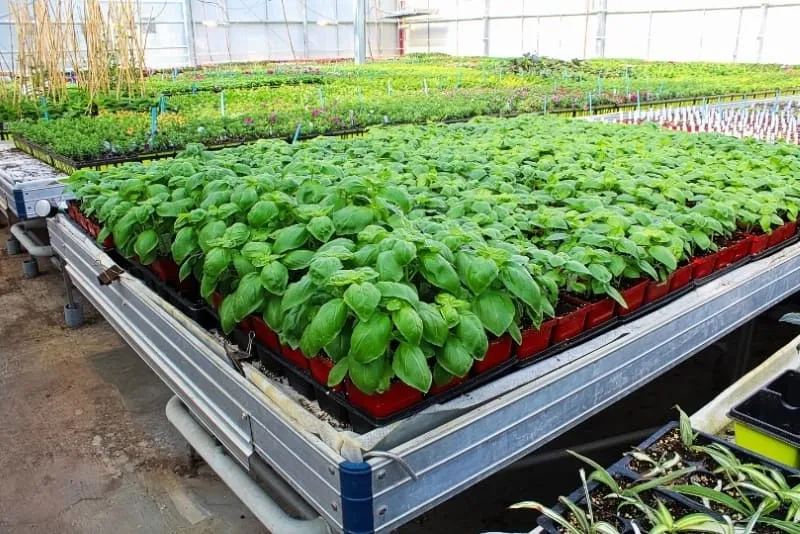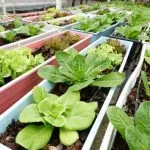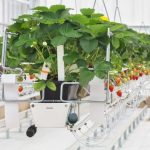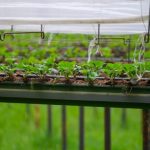Hydroponics is an innovative approach that allows you to grow plants without soil. Ebb and flow hydroponics, also known as flood and drain, is a popular choice among gardeners for its versatility and adaptability. In this system, plants are periodically flooded with water and nutrients, allowing their roots to absorb essential elements while avoiding suffocation. But is this the system for you or will another one be better?

Understanding ebb and flow hydroponics pros and cons is crucial in making an informed decision about whether this method is right for your gardening needs. Throughout this article, you’ll discover the benefits and drawbacks of using ebb and flow systems, from the rapid plant growth it promotes to the maintenance requirements involved. By evaluating these factors, you’ll be well-equipped to decide if ebb and flow is the ideal solution for your horticultural pursuits.
Advantages of Ebb and Flow Hydroponics
Ebb and flow is a hydroponic system that operates on the periodic flooding and draining of plant roots.
Affordability
An ebb and flow hydroponics system is generally an affordable choice, which means you can easily get started with this method without breaking the bank. The components required for this system are relatively low-cost, allowing you to enjoy the benefits of hydroponics without a huge investment. Plus, you’ll likely find that you save money in the long run, as ebb and flow systems use water and nutrients efficiently.
Ease of Use
One of the best things about ebb and flow hydroponics is its ease of use. The system operates on a simple principle: periodically flooding and draining the plant tray with nutrient solution. This means that you don’t have to be a hydroponics expert to set up or maintain an ebb and flow system. With a bit of practice, you’ll find that managing your plants and their growth becomes second nature.
Wide Range of Plant Options
With an ebb and flow system, you can grow a variety of plants, including tomatoes, cucumbers, lettuce, and herbs, among others. This flexibility allows you to experiment with different plant types and discover which ones thrive best in your hydroponic garden. Unlike some other hydroponic methods, like deep water culture or nutrient film technique, ebb and flow is suitable for plants of all sizes, from seedlings to large, mature plants.
Low Maintenance
Ebb and flow hydroponics systems are relatively low-maintenance, making them ideal for busy or beginner gardeners. The periodic flooding and draining process allows for efficient nutrient and water use, minimizing waste and reducing the need for constant monitoring. Additionally, the system is easy to clean and maintain, ensuring that your plants remain healthy and productive.
By choosing an ebb and flow hydroponics system, you’re making a smart decision for your gardening endeavors. The affordability, ease of use, wide range of plant options, and low maintenance requirements of this setup make it a great choice for anyone looking to cultivate a successful hydroponic garden.
Disadvantages of Ebb and Flow Hydroponics
Risk of Pathogens and Algae
In an ebb and flow system, you may face the risk of pathogens and algae growth. Algae thrive in moist and nutrient-rich environments, which are common in hydroponic systems. An algae build-up can compete with your plants for nutrients and reduce the oxygen available to the root system. Pathogens, such as fungi and other harmful organisms, can also contaminate your system, potentially leading to plant diseases and lower yields. To minimize these risks, make sure to maintain proper sanitation of your hydroponic system, and consider using UV sterilizers to help control harmful microorganisms.
Excess Nutrients and Drainage Issues
Ebb and flow systems can sometimes lead to excess nutrient build-up in your growing medium or issues with drainage. If your system floods and drains too often or the nutrient concentration is too high, salt and mineral deposits may accumulate. These deposits can eventually harm your plants by causing nutrient imbalances and toxicity. Ensure that you closely monitor the nutrient levels and adjust them accordingly.
Another drawback you may encounter in the ebb and flow method is incomplete drainage of the nutrient solution after flooding. Poor drainage can lead to stagnant water in your growing medium, which can cause root rot and reduce oxygen availability to the roots. To avoid this, make sure your system is set up properly, and pay attention to the flood and drain intervals to allow for adequate drainage. Using a porous grow medium like Hydropton pebbles or perlite helps with proper drainage and aeration.
Technical Knowledge Requirements
While an ebb and flow hydroponic system is relatively easy to understand and operate compared to other hydroponic methods, it still requires some technical knowledge to set up and maintain. You’ll need to learn about proper nutrient management, understanding flood and drain intervals, and ensuring that your system’s components are functioning correctly. This may involve troubleshooting issues, adjusting water pumps, timers, or replacing parts as needed. If you’re new to hydroponics, don’t be discouraged by these challenges but commit to enhancing your understanding to get the most out of your ebb and flow system. We have a comprehensive guide to help you build your own ebb and flow hydroponic system.
In conclusion, an ebb and flow hydroponics system offers several advantages, but it also has its own set of challenges, including the risk of pathogens and algae, excess nutrients and drainage issues, and the need for technical knowledge. By learning how to properly manage these challenges, you can maximize the potential of your hydroponic system and enjoy a successful harvest.
Alternate Hydroponic Systems
In addition to Ebb and Flow hydroponic systems, there are other popular systems with different working methods. In this section, we’ll discuss three such alternatives – Deep Water Culture, Nutrient Film Technique, and Drip Systems.
Deep Water Culture (DWC)
In Deep Water Culture systems, your plants are suspended in a nutrient-rich water solution. Their roots are completely submerged in the solution, and air stones provide constant oxygen supply, promoting strong and healthy root development. This method encourages faster growth compared to other hydroponic methods and with lower maintenance, as there are fewer moving parts. However, it is not suitable for large plants with extensive root systems and it is sensitive to power failures, as air stones need constant power to provide oxygen to the roots.
Nutrient Film Technique (NFT)
The Nutrient Film Technique system uses a thin film of water flowing over your plants’ roots. The roots are exposed to the nutrient-rich solution while suspended in a sloping channel. This method boasts an efficient use of water and nutrients and is easy to set up and expand. However, it is suitable for plants with small root systems and not for heavy or large plants. It requires constant water movement to keep the nutrient film flowing, so system failure can lead to rapid plant stress or death.
Drip Systems
Drip Systems use drip emitters connected to a nutrient reservoir to deliver the solution directly to your plants’ roots. This way, excess water can be easily collected and recycled, making it an economical method. It boasts precise nutrient delivery to each plant, maximizing efficiency and is easy to scale and suitable for both small and large plants. You have the flexibility to switch plants without disturbing the entire system. However, this system is more prone to clogging and requires regular maintenance of drip emitters, and the nutrient solution requires monitoring and adjusting to maintain optimal levels.
By considering your specific growing needs and preferences, you can explore these alternate hydroponic systems to find the best fit for your gardening journey.







